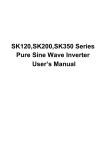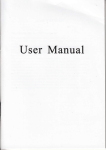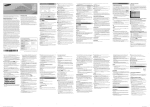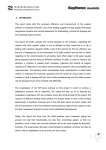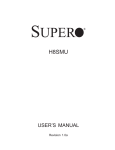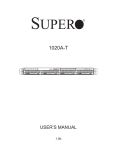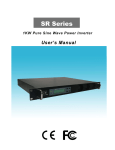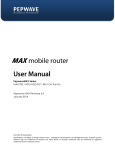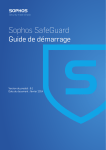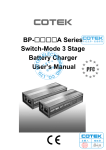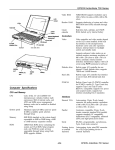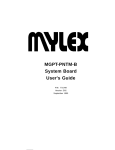Download Mylex MPE-PNTM System Board
Transcript
MPE-PNTM System Board BIOS User’s Guide P/N: 771920-DO2 Version DO2 August, 1994 Preface MPE-PNTM BIOS User’s Guide PREFACE Thank you for your choice of a Mylex MPE-PNTM System Board product. With proper installation and care, your Mylex System Board will operate for years without any service requirement. This Installation and Operation Guide will guide you in the installation process. The information contained herein is subject to change without notice. BIOS Modifications For information on Mylex’s modifications to the AMIBIOS, please refer to the “Appendix A” section of this manual. Hardware The MPE-PNTM motherboard uses the NCR53C810 PCI SCSI chip to interface with standard/fast SCSI drives. The NCR53C810 resides on the PCI bus allowing high-speed transfers from the SCSI drives. Mylex does not represent or warrant that this Installations and Operations Guide is correct in any or all respects, and shall not be liable for technical or editorial omissions or errors made herein. Except as specifically provided herein, Mylex makes no warranties, express or implied, respecting this guide or the Mylex products referred to herein, including but not limited to any warranty of design, merchantability, or fitness for a particular purpose, even if Mylex has been informed of such purpose. P/N: 771920~DO2 (DCopyright 1994 Mylex bY Corporation P.O. Box 5035 Fremont, California 94537-5035 Copyright (0 1994 Version DO2 i MPE-PNTM BIOS User’s Guide Preface Copyright Notice This manual is copyrighted by Mylex Corporation. It may not, in whole or in part, be copied, reproduced, photocopied, translated on paper, electtvnic media or computer-readable-form or be used to make a derivative work, without written permission from Mylex Corporation, except as permitted by the United States Copyright Act of 7976, as amended. FCC Warning This device has been tested and found to comply within the limits of a Class B device, pursuant to Part 15 of FCC regulations. Operation is subject to the following two conditions: 1) This device may not cause harmful interference, and 2) this device must accept any interference received, including interference that may cause undesired operation. This equipment has been designed to provide reasonable protection against harmful interference in a residential area. This equipment generates, uses and can radiate radio frequency energy. This device, if not installed and used in accordance with the manufacturer’s instructions, may cause harmful interference to radio communications. There is no guarantee, however, interference will not occur in a particular installation. Should it be determined that this equipment is causing interference to radio or television reception, the following suggested actions may be taken. Reorient or relocate the receiving antenna. Increase the distance between the antenna and the computer. Plug the computer into a different AC outlet so that the two conflicting devices are using a different branch circuit. Contact the dealer that sold this equipment and/or a reputable radio/television service technician for additional suggestions. .. I Version DO2 Copyright 0 1994 Preface MPE-PNTM BIOS User’s Guide CAUTION Only equipment certified to comply with Class B (computer input/output devices, terminals, printers, etc.) should be attached to this equipment, and must have shielded interface cables. Finally, any changes or modifications to the equipment by the user not expressly approved by the guarantee or manufacturer could void the users authority to operate such equipment. Trademarks Mylex and MPE-PNTM are registered trademarks of Mylex Corporation. All other products and companies are trademarks of their respective owners and licensees. Mylex Warranty - Customer Service Policy One Year Limited Warranty This product is guaranteed to be free from manufacturing or material defects for a period, of 1 (one) year after the date of purchase. Should the product fail during this period Mylex will repair or replace (at Mylex’s option) the product free of charge with the following provisions: 1) Proof of purchase must be provided. 2) The product must have been properly installed in accordance to the documentation provided. 3) The product must not have been modified by any party except by Mylex or an authorized agent. 4) The product must be free of damage. Any software, including firmware, is provided “as-is” without warranty of any kind, expressed or implied. The purchaser bears complete risk of the performance and quality of the software. Mylex’s sole responsi- Copyright @ 1994 Version DO2 ... Ill Preface MPE-PNTM BIOS User’s Guide bility, and the purchaser’s only remedy to any defect in workmanship, shall be replacement of the defective medium (diskette or ROM). All expressed or implied warranties for the MPE-PNTM, including, but not limited to, warranties of merchantability and fitness for a particular purpose, are restricted to the duration of the warranty period. Under no circumstances shall Mylex be held liable, in any way, to the purchaser for damages, including any lost profits, lost savings, or other incidental or consequential damages arising out of the use of, or inability to use this product. Some states do not allow warranty or liability restrictions or limitations, so the preceding limitations may not apply to you. Returned Merchandise Authorization (RMA) All products returned to Mylex for warranty service or for other reasons, must be assigned a RMA number before shipment to Mylex. The RMA number may be obtained by contacting Mylex’s Technical Support Department. Any product received without a RMA number will be returned to the shipper unopened. /mportanr Elofe: Only the company (or individual) that purchased the product directly from Mylex may obtain an RMA number. If the Mylex product was purchased from a reseller or distributor, you must contact that company for service. The following rules/procedures apply to all RMA’s: 1) The product must be returned in original packaging or other suitable materials. 2) Each returned unit will be inspected for damage or other irregularities. If a unit is shown to be modified, the customer will be notified before any action is taken. 3) Mylex will not be responsible for non-Mylex products shipped with an RMA unit. This includes memory, math co-processors and other internal and external peripherals. Products must be shipped to Mylex with freight paid. Upon completion of service, Mylex will ship the product back UPS Ground or similar service, at no charge, unless prior arrangements have been made. Iv Version DO2 Copyright (0 1994 Preface MPE-PNTM BIOS User’s Guide Customer Service Mylex Technical Support is available 8:00 a.m. to 500 p.m. pacific standard time, Monday through Friday except holidays. They can be reached at (510) 796-6100 or by FAX at (510) 7457715. If you purchased a system with this board, please contact your system supplier. Copyright (Q 1994 Version DO2 V MPE-PNTM BIOS User’s Guide Table of Contents Table of Contents Chapter 1: Introduction SystemBlOS..............................................l2 Configuration Data. ......................................... l-2 How Data is Configured ..................................... l-2 Types of AMIBIOS SETUP ................................... l-3 Chapter 2: PCI Local Bus What PCI Accomplishes ..................................... 2-l PCI Features . . . . . . . . . . . . . . . . . . . . . . . . . . . . . . . . . . . . . . . . . . . . . . 2-l OtherPCIFeatures.........................................22 Buffered Read and Writes . . . . . . . . . . . . . . . . . . . . . . . . . . . . . . . . . . . . 2-3 Concurrent Operation ....................................... 2-3 Bus Mastering . . . . . . . . . . . . . . . . . . . . . . . . . . . . . . . . . . . . . . . . . . . . . 2-3 Burst Mode . . . . . . . . . . . . . . . . . . . . . . . . . . . . . . . . . . . . . . . . . . . . . . . 2-3 Multiplexing . . . . . . . . . . . . . . . . . . . . . . . . . . . . . . . . . . . . . . . . . . . . . . . 2-3 PCI Component Classes. .................................... 2-4 Chapter 3: Standard SETUP Date, Day and Time Configuration ............................. 3-l Hard Disk C: Type/Hard Disk D: Type ......................... 3-l Entering Drive Parameters ................................... 3-2 Hard Disk Drive Types ...................................... 3-3 Using Auto Detect Hard Disk (only for IDE drives). ................ 3-5 Floppy Drive A:/Floppy Drive B: ............................... 3-5 Copyright Q 1994 Version DO2 vii Table of Contents MPE-PNTM BIOS User’s Manual Chapter 4: Advanced SETUP Default Settings. ........................................... 4-l Optimal Defaults. ....................................... 4-l Fail-Safe Defaults. ...................................... 4-l Advanced SETUP Options. .................................. 4-2 Typematic Rate (CharsSec) .............................. 4-2 Mouse support . . . . . . . . . . .................................. 4-2 Above 1 MB Memory Test. . . . . . . . . . . . . . . . . . . . . . . . . . . . . . . . . . . . 4-2 Memory Test Tiik Sound . . . . . . . . . . . . . . . . . . . . . . . . . . . . . . . . . . . . 4-3 Parii Error Check. . . . . . . . . . . . . . . . . . . . . . . . . . . . . . . . . . . . . . . . . . 4-3 Hit “Del” Message Display . . . . . . . . . . . . . . . . . . . . . . . . . . . . . . . . . . . 4-3 Extended BIOS RAM Area. . . . . . . . . . . . . . . . . . . . . . . . . . . . . . . . . . . 4-4 Wait for “Fl” If Any Error . . . . . . . . . . . . . . . . . . . . . . . . . . . . . . . . . . . . 4-4 System Boot Up Num Lock . . . . . . . . . . . . . . . . . . . . . . . . . . . . . . . . . . 4-4 Floppy Drive Seek At Boot. . . . . . . . . . . . . . . . . . . . . . . . . . . . . . . . . . . 4-5 System Boot Up Sequence . . . . . . . . . . . . . . . . . . . . . . . . . . . . . . . . . . 4-5 System Boot Up CPU Speed ................................. 4-5 Cache Memory ............................................ 4-5 External Cache Mode. ...................................... 4-6 Adapter Shadow Cacheable. ................................. 4-6 System BIOS Shadow Cacheable ............................. 4-6 Password Checking ........................................ 4-6 ISA Video ROM COOO, 32K .................................. 4-7 IDE Block Mode ........................................... 4-8 Auto Keylock Timeout. ...................................... 4-6 Chapter 5: Chipset SETUP Base Memory Size ......................................... Host-To-Host Memory Posting ................................ Host-To-PC1 Posting. ....................................... PCI-To-Memory Posting ..................................... DRAM Speed . . . . . . . . . . . . . . . . . . . . . . . . . . . . . . . . . . . . . . . . . . . . . ISA VGA Frame Buffer Size. ................................. ... VIII Version DO2 5-l 5-l 5-l 5-l 5-2 5-2 Copyright 0 1994 MPE-PNTM BIOS User’s Guide Table of Contents ISA VGA Frame Buffer Base Address (Memory Hole). ............. 5-3 ISAIRQ9 . . . . . . . . . . . . . . . . . . . . . . . . . . . . . . . . . . . . . . . . . . . . . . . . . 5-4 ISAIRQ10................................................55 ISAIRQll . . . . . . . . . . . . . . . . . . . . . . . . . . . . . . . . . . . . . . . . . . . . . . . . 5-5 ISAIRQ15................................................56 PCI VGA Palette Snooping. .................................. 5-6 On-Board PCI SCSI Controller. ............................... 5-6 PCISCSIBIOS . . . . . . . . . . . . . . . . . . . . . . . . . . . . . . . . . . . . . . . . . . . 5-6 PCI IDE Card Present In. .................................... 5-7 PCI IDE IRQ .............................................. 5-8 Chapter 6: Power Management SETUP IDE Standby Power Down Mode .............................. 6-l Chapter 7: Peripheral SETUP Programming Mode. ........................................ 7-1 On-Board FDC. ............................................ 7-2 On-Board IDE Drive ........................................ 7-2 Serial Port l............................................... 7-2 Serial Port 2. .............................................. 7-3 Parallel Port. ......... J. ................................... 7-3 IRQ Active State ........................................... 7-3 IRQ Active State ........................................... 7-3 Parallel Port Mode. ......................................... 7-3 Copyright c8 1994 Version DO2 ix MPE-PNTM BIOS User’s Manual lMWhJCti0n Chapter 1: Introduction This manual documents the AMIBIOS for the Intel Mercury Chipset with SMC FCD637C665 support, designed for a Pentium-based EISA computer system with an SMC FDC637C665 Super I/O Controller. This AMIBIOS also supports the NCR SCSI 810 chip on the PCI local bus. There is no generic AMIBIOS for the Intel Mercury chipset. Because of the complex issues involving this chipset, the AMIBIOS must be customized for each system based on the Mercury chipset. This manual describes both the AMIBCP options that may be used by the system integrator to configure this BIOS and the AMIBIOS Setup utility that is one of the outputs when the AMIBIOS ROM files described in this manual are used with the American Megatrends AMIBCP BIOS Configuration Program. This AMIBIOS also supports the Intel PCI (Peripheral Component Interconnect) local bus specification. This AMIBIOS includes support for: l l l The SMC FCD637C665 Super I/O Controller The NCR 53C810 PCI SCSI BIOS V1.07 The Weitek 5816 Video BIOS ~1.50. Please see the Intel, NCR, ATI, Weitek, and SMC technical documentation for additional information. Copyright (0 1994 Version DO2 l - l Introduction MPE-PNTM BIOS User’s Manud System BIOS The BIOS is the basic input output system used in all IBM@ PC-, Xp -, AT@, and PS/2@ compatible computers. The AMIBIOS is a high-quality example of a system BIOS. Configuration Data AT-Compatible systems, also called ISA (Industry Standard Architecture) must have a place to store system information when the computer is turned off. The original IBM AT had 84 bytes of non-volatile memory storage in CMOS RAM. All AT-Compatible systems have at least 84 bytes of CMOS RAM, which is usually part of the Real Time Clock. Many systems have 128 bytes of CMOS RAM. How Data Is Configured AMIBIOS provides a Setup utility in ROM that is accessed by pressing <Del> at the appropriate time during system boot. Setup configures data in CMOS RAM. The AMIBIOS Setup utility included in the AMIBIOS for the Intel Mercury Chipset can also be executed via a hot key. 1-2 Version DO2 Copyright (0 1994 Introduction MPE-PNTM BIOS User’s Manual Types of AMIBIOS Setup ;::. .:..:::..,. ,A., ,.,... . . . . . . . . ,.,.. .,. . . . . . .,. ,._., .;. .~,~.~_~,~.~.~.~.~_~.~ .._.. ~.~.~.~.~_~_~.~.~_~.~.~.~.~.~.~.~.~.~.~.~,~. ::::: ,._.i,.,. .,.:. . ,. . . . . . ,.,. .,. ,. . ., ._.,. . . . . .,. llijjiiiiiiiiiiiiiiiiiiiijijijiiiiiiiiii. ;:,. ::. _._.:, ., . . ,.,., . . . . . ._. . . ._ . ,.,. _. . .,. ._.,.,. .:,.,. .,., .: ,:. . .~,~.~.~.~.~.~.~.~_..~.~.~.~.~,.~.~.~.~.~,. ~.~.~.~.,~. ~.~.~.~.~.~.~.~.~.~.~.~.~.~ .: :::.:::::::::::::::::::::::::::::::::::i:::::::::::::::::::::::::::::::::::::::::::::~:::~;:::::::::::::::::::::::::;::::::::::::::::::::::~:::~~:::: Standard SETUP Sets time, date, hard disk type, types of floppy drives, monitor types, and if keyboard is installed. Advanced SETUP Sets Typematic Rate and Delay, Above 1MB Memory Test, memory Test Tick Sound, Hit <Del> Message Display, System Boot Up Sequence, and many others. Chipset SETUP Sets chipset-specific options and features. Peripheral SETUP Controls l/O Controller-related options. Power Management SETUP Controls power conservation options. .. . . . . . . . . . . . . . .~ ~. ~ .~_~. .~. ~ ~. .~. . . ~. .~. ~ ~. .~. ~ ~. .~._~.~.~.~.~.~.~.~.~.~.~.~. ~.~.~.~.~.~,~,. ~ _.: , .::: ;:. .: :::. .:::.. . ,. . . ._. . :.,............................ . (..,_..,:.,. ,.:_._,. :(._(.._ ,.:,_.,. ,_.,._,. .,._,..,.,_.:,_. ,.:,.:,.,.,_., . . ,.:,.,:.. ,.:, . ,.,:.,.,. .,. .,..,.. ..,. ,.:, . .,., ,.,. _,.,,.,. .,. _,. .:,..,:. ., .,.,. . .,.,. .,.,. .,.,. .,. . .,.,.,.,. ..:..::::::. . . . i. :_i:i:;i.i:i.:.:~~~~~~~~~~~~~~~~~~~~~~i~~~~~~~~~~~~~~DE~R~~iolNii:.;~;i._..(i.ci:i~ ,.,.,.,.,.,.,.,.,._.,.,. .,.,.,.,. .,. . .,.,. .,.,.,.,.,.,. . .,.,.,. .,.,.,.,.,.,.,.,.,. .,.,.,.,.,. .,.,. .,.,. .,.,.,.,.,.,.,.,.,.,.,.,. .,.,.,.,.,.,._. ,.,.,.,..,,..,,..,,..,,.,,..,(..,(..,,..,,..,,.,.,.,,..:,.:..:,.::..:.:.::..:+: :...::: :. ,.,.I...._.::_.:::: .~...A... :: ::::. .,,.,... ., .__. .: ,,.,.,., ,.. ..: .A..._... .::::::. ,.:.~:.:.:.:.:.:_:.:.:.:.:,:.:.:.:.:.~:.:.:.:.:.:.:.:.:.:.,._.,.,. ;._.?,.,.,.,.,._. :.,.: .,.;:.:.:.:.:.:.:.:.:.:.:.:.:.:.:.:.~:.:...~~~.:.:.:.:.:.~~, :.:. ~.~.~.~.~.~.~.~.~.~.~.~.~.~.~.~.~.~.~.~.~.~~.~:~:~:.~:.:.:~:.:.’.~.‘.‘~‘.‘.‘.‘.‘.‘.‘.‘~‘. ..,.: ,A.,... ,...,. Detect C Autodetect IDE Drive Detect D I Autodetect IDE Drive Colorset Copyright Q 1994 .. Allows you to change the BIOS Setup screen colors. Version DO2 1-3 Introduction MPE-PNTM BIOS User’s Manual Password Allows you to enter a userselected password that will enable this option. Antivirus Enable/Disable antivirus protection. For default values. Original I Optimal ) For best performance. I I l-4 Fail Safe Version DO2 For safest default values Copytig ht (B 1994 MPE-PNTM BIOS User’s Manual PCI Local Bus Chapter 2: PCI Local Bus PCI is a specification for a local bus standard. The PCI specification also provides the electrical specifications for peripheral chip makers and the logic requirements for a PCI Controller. While PCI defines a local bus standard, it also defines a standard component-level interface. PCI is a common I/O component interface. The PCI Local Bus Specification is a standard set of interface, architecture, timings, electrical, and physical specifications that permits all PCI Local Bus products to be totally interchangeable. PCI is a multiplexed extension of the CPU bus. In PCI, the CPU bus control mechanisms have been extended to optimize I/O support. PCI establishes a local bus standard in which a large variety of I/O components can be directly connected without using any glue logic. What PCI Accomplishes PCI is a way to physically interconnect highly integrated peripheral components and processor/memory systems. PCI Features Up to ten PCI loads can be used in the same system on the PCI bus, including the PCI Controller and an expansion bus controller for EISA, ISA, or MCA. PCI decouples the CPU from the expansion bus and works Copyright (0 1994 Version DO2 2- 1 MPE-PNTM BIOS User’s Manud PCI Local Bus at 33 MHz but can use either a 32-bit or 64-bit data connection path to the CPU. Other PCI Features . Processor-independent, . Has a multiplexed address, command, and data bus and supports burst mode operation on reads and wriies, . Runs synchronous with the CPU at speeds up to 33 MHz, . Has a maximum data transfer rate of 120 MBs (with a peak rate of 132 MBs on a 32-bit data path), . Has a maximum data transfer rate of 240 MBs (with a peak rate of 264 MBs on a 64-bit data path), . Has an optional 64-bit data path that is transpar- ently interoperable with the 32-bit data path, . Has low latency random accesses (about 60 ns write access latency) to slave registers from a PCI bus master on the PCI bus, . Is capable of full concurrency with the processor and PCI bus masters, . Has full multimaster capability, allowing any PCI Master peer-to-peer access to any PCI slave, . Has hidden and overlapped central arbitration, . Has a low pin count (master - 47; slave - 49, . Has address and data parity, and . Uses three physical address spaces: 32-bit mem- ory, 32-bit I/O, and a 256 byte-per-agent configuration space. 2-2 Version DO2 Copyright @ 1994 MPE-PNTM BIOS User’s Manual PCI Local Bus Buffered Reads and Writes The PCI Controller buffers reads and writes between the memory/CPU and PCI peripheral devices. Concurrent Operation The CPU in a PCI system runs concurrently with PCI bus mastering peripherals. Although bus mastering peripheral devices are arbitrated, significant data transfer rate improvements can be achieved without splitting resource utilization between the CPU and a bus mastering device. Peripheral devices can operate at up to 33 MHz in a PCI environment. Bus Mastering PCI devices can be bus masters, slaves, or a combination of bus master and slave. Burst Mode The PCI specification also provides for burst mode of any length for both reads and writes. Multiplexing PCI is a multiplexed bus. Multiplexing allows more than one signal to be sent on the same electrical path. Copyright (D 1994 Version DO2 2-3 PCI Local Bus MPE-PNTM BIOS User’s Manual The control mechanisms have been modified and extended to optimize l/O support. PCI Component Classes PCI components must be one of three classes: l Bus master, 0 Slave, or l 2-4 Master/slave combination. Version DO2 Copyright (0 1994 MPE-PNTM BIOS User’s Manual Standard SETUP Chapter 3: Standard SETUP The AMIBIOS Setup options described in this section are selected by choosing the appropriate high-level icon from the Standard Setup screen. Standard Setup is selected from the Setup section on the AMIBIOS Setup main menu (see the previous page). All displayed icons are described in this section, although the screen display is often all you need to understand how to set the option. Date, Day and Time Configuration Select the Standard option. Select the Date and Time icon. The current values for each category are displayed. Enter new values through the keyboard. Hard Disk C: Type/Hard Disk D: Type Select one of these hard disk drive icons to configure the drive named in the option. A scrollable screen that lists all valid disk drive types is displayed. Select the correct type and press <Enteo. If the hard disk drive is an IDE drive, select Detect C: or Detect D: from the Utility section of the AMIBIOS Setup main menu to have AMIBIOS automatically detect the IDE drive parameters and report them to this screen. Copyright (0 1994 Version DO2 3-l Standard SETUP MPE-PNTM BIOS User’s Manual Entering Drive Parameters You can also enter the hard disk drive parameters. The drive parameters are: Tme Cylinders Heads The number of cylinders in the jisk drive. The number of heads. Write Precompensation This size of a sector gets xogressively smaller as the rack diameter diminishes. Yet 2ach sector must still hold 512 Dytes. Wriie precomensation 5rcuitry on the hard disk compensates for the physical difference in sector size by boosting the write current for sectors on inner tracks. This parameter is the track number uvhere write precomensation begins. Landing Zone The number OS the cylinder location where the heads will normally park when the system is shut down. Sectors 3-2 The number for a drive with :ertain identification parameters. The number of sectors per track. MFM drives have 17 sectors per track. RLL drives have 26 sectors per track. ESDI drives have 34 sectors per track. SCSI and IDE drives may have even more sectors per track. Version DO2 Copyright @ 1994 MPE-PNTM BIOS User’s Manual Standard SETUP Capacity The formatted capacity of the drive is (Number of heads) x (Number of cylinders) x (Number of sectors per track) x (512 bytes per sector). Hard Disk Drive Types Not Installed 1 1 306 2 615 3 615 + 4 1 940 5 940 6 615 + 6 1 300 I 615 -t-+-k4 1 65535 I 1 I 256 17 1 62MB 17 47MB 615 17 20MB 511 17 31MB 733 17 30MB 901 17 112MB 7 1 462 8 8 1 733 5 1 900 15 820 3 1 65535 1 820 17 20MB 5 1 65535 1 855 17 35MB 65535 1 855 1 9 10 11 855 -+ 12 1 855 7 1 13 I 306 8 14 ( 733 7 ( Copyri9ht (Q 1994 65535 1 I ) 65535 1 128 65535 1 Version DO2 I 319 733 3-3 MPE-PNTM BIOS User’s Manual Standard SETUP 34 612 2 128 612 17 10MB 35 1024 9 65535 1024 17 77MB 36 1024 8 512 1024 17 68MB 37 615 8 128 615 17 41MB 38 987 3 987 987 17 25MB 3-4 Version DO2 Copyright 0 1994 MPE-PNTM BIOS User’s Standard SETUP Manual 45 917 15 65585 918 17 114MB 46 1224 15 65585 1223 17 152MB 47 USER-DEFINED HARD DRIVE -- ENTER USERSUPPLIED PARAMETERS. ESDI SCSI Using Auto Detect Hard Disk (Only for IDE Drives) If you select Detect C: or Detect D: from the Utility section of the AMIBIOS Setup main menu, AMIBIOS automatically finds all IDE hard disk drive parameters. AMIBIOS places the hard disk drive parameters that it finds in the Drive C: Type or Drive D: Type fields in Standard Setup. Floppy Drive A:/Floppy Drive B: Move the cursor to these fields via and and select the floppy type. The settings are 360 KB 5bI4 inch, 7.2 MB 91’4 inch, 720 KB 31/z inch, 1.44 MB S1& inch, or 2.88 MB 3’/2 inch. Copyright (0 1994 Version DO2 3-5 MPE-PNTM BIOS User’s Manual Advanced SETUP Chapter 4: Advanced SETUP The Advanced Setup options that will be included in the AMIBIOS Setup generated through AMIBCP and the AMIBIOS for the Intel Mercury chipset with SMC 665 support are described in this chapter. Although these options are described in the American Megafrends AMIBIOS User’s Guide for the 12/l 5’93 coreAM/B/OS, they are also described in this manual, since AMIBIOS is new and unfamiliar to most American megatrends clients. Default Settings Every option in AMIBIOS Setup contains two default values: an Fail-Safe default and the Optimal default value. Optimal Defaults The Optimal default values provide optimum performance settings for all devices and system features. Fail-Safe Defaults The Fail-Safe default settings consist of the safest set of parameters. Use them if the system is behaving erratically. They should always work but do not provide optimal system performance characteristics. Copyright (0 1994 Version DO2 4-l MPE-PNTM BIOS User’s Manual Advanced SETUP Advanced Setup Options Typematic Rate (CharslSec) This option sets the rate at which characters displayed on the screen repeat when a key is pressed and held down. The settings are Disabled, 15,20, or 30 characters per second. The Optimal default setting is 30 cps. The Fail-Safe default setting is Disabled. Mouse SUDDOrt When this option is set to Enabled, AMIBIOS supports a PS/2-type mouse. The settings are Enabled or Disabled. The Optimal default setting is Enabled. The Fail-Safe default setting is Disabled. Use Disabled if a PS/2 mouse is not being used. Above 1 MB Memory Test When this option is set to Enabled, the AMIBIOS memory test is performed on all system memory. When this option is set to Disabled, the memory test is done only on the first 1 MB of system memory. The settings are Enabledor Disabled. The Optimal default and Fail-Safe default settings are Disabled. 4-2 Version DO2 Copyright Q 1994 MPE-PNTM BIOS User’s Manud Advanced SETUP Memotv Test Tick Sound This option enables (turns on) or disables (turns off) the ticking sound during the memory test. The settings are Enabled or Disabled. The Optimal defautt and Fail-Safe default settings are Enabled. Paritv Error Check This option enables or disables parity error checking for system RAM. The settings are Enabled (all system RAM parity is checked) or Disabled (parity is checked only on the first 1 MB of system RAM). The Optimal defautt and Fail-Safe defautt settings are Disabled. Hit “DEL” Message Display Disabling this option prevents Hit <Del> if you want to run Setup from appearing when the system boots. The settings are Enabled or Disabled. The Optimal default and Fail-Safe default settings are Enabled. Copyright 0 1994 Version DO2 4-3 MPE-PNTM BIOS User’s Manual Advanced SETUP Extended BIOS RAM Area Specify in this option if the top 1 KB of the system programming area beginning at 639K (DOS 7K) or address 0:300 in the AMIBIOS area in low memory will be used to store extended BIOS RAM information. The settings are DOS IKor 0:300. The Optimal default and Fail-Safe default settings are 0:300. For extended BIOS RAM area, set this option to 0:300. Wait for “Fl” If Any Error AMIBIOS POST runs system diagnostic tests that can generate a message followed by: Press <Fl> to continue If this option is set to Enabled, AMIBIOS waits for the end user to press before continuing. If this option is set to Disabled, AMIBIOS continues the boot process without waiting for to be pressed. The settings are Enabled or Disabled. The Optimal default and FailSafe default settings are Enabled. System Boot Up Num Lock When this option is set to On, AMIBIOS turns off Num Lock when the system is powered on so the end user can use the arrow keys on both the numeric keypad and the keyboard. The settings are On or OH. The Optimal default and Fail-Safe default settings are On. 4-4 Version DO2 Copyright (0 1994 MPE-PNTM BIOS User’s Manual Advanced SETUP Floppy Drive Seek At Boot When this option is set to Enabled, AMIBIOS performs a Seek command on floppy drive A: before booting the system. The settings are Enabled or Disabled. The Optimal default and Fail-Safe default settings are Disabled. System Boot Up Sequence This option sets the sequence of boot drives (either floppy drive A: or hard disk drive C:) that AMIBIOS attempts to boot from after AMIBIOS POST completes. The settings are C:,A: or A.$:. The Optimal default setting is &A.-. The Fail-Safe default setting is A:, C:. Cache Memory This option enables internal (on the microprocessor) and secondary (external) cache memory. If Both is selected, internal cache and external cache memory is enabled. If Infernal is chosen, only the internal cache memory in the Pentium CPU is enabled. If Disabledis chosen, all cache memory is disabled. The settings are Internal, Disabled, or Both. The Optimal default setting is Both. The Fail-Safe default setting is Disabled. Copyright (D 1994 Version DO2 4-5 Advanced SETUP MPE-PNTM BIOS User’s Manual External Cache Mode This option selects the type of caching algorithm used by AMIBIOS and the computer for L2 (external) secondary cache memory. The settings are Wr-Thou or W-Back. The Optimal default setting is Wr-Back. The Fail-Safe default setting is Wr-Thm. Adapter Shadow Cacheable Once any Adapter BIOS is shadowed in RAM, using the ISA Adapter ROM options, this option could be used to cache the shadow RAM. Enable this option only if all the adapters that have ROM shadowed, work properly with this option disabled. If enabling this option results in problems, immediately disable this. If all the Adapter BIOS ROMs are not shadowed, leave this option as disabled. System BIOS Shadow Cacheable If enabled, this option will make the BIOS area EOOO:O to FFFF:F cachable. Disable this only for a fail safe operation. Password Checking This option is only valid if the password is defined under security. Options are Setup or Always. Setup will only check the password when entering into CMOS setup. Always will check the password when booting. 4-6 Version DO2 Copyright Cp 1994 MPE-PNTM BIOS User’s Manual Advanced SETUP ISA Video ROM COW, 32K When this option is set to Enabled, the video ROM area from COOOOh - C7FFFh is copied (shadowed) from ROM to RAM for faster execution. The settings are Absent, Present, or Shadow. l l l l l ISA Adapter ROM C800,16K ISA Adapter ROM CCOO,16K ISA Adapter ROM DO00,16K ISA Adapter ROM D400,16K ISA Adapter ROM D800,16K These options enable shadowing of the contents of the ROM area beginning at the address named in the option title (for example, the Shadow 0, 16K option can enable shadowing of the contents of the ROM area from C8000h - CBFFFh to RAM. The settings are Absent, Present, or Shadow. The ROM area that is not used by ISA adapter cards will be allocated to PCI adapter cards. If no ISA adapter ROM exists at the location, make sure the option is marked as Absent, so that the PCI boards can be automatically configured to use these ROM areas. If the option is set to Present, it means there is an ISA adapter ROM present in this address and the ISA adapter ROM will not be shadowed and this address can not be used for PCI option ROM. If the option is set to Shadow, it means there is a ISA adapter ROM present in this address and ISA adapter ROM will be shadowed. Therefore, this address cannot be used for PCI option ROM. Copyright (0 1994 Version DO2 4-7 Advanced SETUP MPE-PNTM BIOS User’s Manual IDE Block Mode This option enables multiple sector reads and writes for IDE drives. The settings are EnaMedor Disabled. The Optimal default setting is Disabled. The Fail-Safe defautt setting is Enabled. WARNING! Do not enable this option if the IDE hard disk does not support block mode. File corruption will result. 4-0 Version DO2 Copyright a3 1994 MPE-PNTM BIOS User’s Manual Chioset SETUP Chapter 5: Chipset Setup Base Memory Size This option sets the size of the base system memory. The settings are 512 KB or 640 KB. The Optimal and Fail-Safe default settings are 640 KB. Host-To-Host Memory Posting The settings are Enabled or Disabled. The Optimal and Fail-Safe default settings are Disabled. If any bus mastering boards are in the system, the host-to-host memory posting must be set to disabled. Host-To-PC1 Posting Enable this option for better performance. PCI-To-Memory Posting The settings are Enabled or Disabled. The Optimal and Fail-Safe default settings are Disabled. Enable this option for better performance. Copyright ((3 1994 Version DO2 5-1 Chipset SETUP MPE-PNTM BIOS User’s Manual DRAM Speed This option specifies the type of DRAM system memory used in this computer. The settings are Slow or Fast. The Optimal and Fail-Safe default settings are Slow. This setting is a future option. Do not enable. ISA VGA Frame Buffer Size This option must be set to Enabled if the VGA adapter card installed in the system requires a frame buffer. This option sets the size of the VGA frame buffer. The settings are Disabled, 7 MB, 2 MB, or 4 MB. The Optimal and Fail-Safe default settings are Disabled. 5-2 Version DO2 Copyright (D 1994 MPE-PNTM BIOS User’s Manud Chipset SETUP ISA VGA Frame Buffer Base Address (Memory Hole) This option sets the base address (or starting point) of the VGA frame buffer. This option must be set to Enabled if the VGA card installed in the system requires a frame buffer. The settings are dependent on the setting of the ISA VGA Frame Buffer Size option as shown in the following table.Also see the table to create a memory hole below 16MB. Disabled I N/A I 1MB I 15MB - 16MB I 2MB I 14MB - 16MB I 4MB I 12MB - 16MB I The Optimal and Fail-Safe default settings are (MA). Copyright (D 1994 Version DO2 5-3 MPE-PNTM BIOS User’s Manud Chipset SETUP ISA IRQ 9 IRQ x: Four setup options are available for PCI IRQs; i.e., the IRQs that can be assigned to PCI devices. They are IRQ9, IRQl 0, IRQll , and IRQ15. The setup option for each IRQ is either ‘ISA’ or ‘PCI’. When set to ‘ISA’, the designated IRQ is not available for PCI devices and. If set to ‘PCI’, the designated IRQ will be available for PCI devices. The IRQs that are available for PCI devices are albcated in the following manner, First, all available IRQs are allocated to the PCI devices so that the interrupt does not have to share. If there are no more available IRQ numbers, then an already-used IRQ will be allocated, in which case that IRQ must be sharable. For example, if two PCI cards are present and if IRQ9, IRQlO, and IRQll are available for PCI, then the on-board SCSI PCI card in slot land the PCI card in slot 2 each will be allocated a unique IRQ. But if only two IRQsare available, such as IRQ9 and IRQll , then IRQ9 must be sharable. The on-board SCSI port in the Pentium Motherboard actually sits on the PCI bus, without taking up any PCI slots. Note: The on-board SCSI port, enabled through the on-board PCI SCSI device option, will consume an interrupt. Hence, if the on-board SCSI port is enabled, make sure an IRQ is made available to it, by assigning it to PCI. IRQ9 should be set to ISA. PCI IRQ: Set to Level normally. This setting also allows sharing of PCI interrupts. Make sure all the PCI cards can operate with the setting defined here. 5-4 Version DO2 Copyright (23 1994 MPE-PNTM BIOS User’s Manual ChiPset SETUP At least one IRQ must be free for each PCI adapter card in the system. If the PCI adapter card includes a multifunction device, at least two or more IRQs must be free. The settings are Free or Used. The Optimal and Fail-Safe default settings are Free. Set IRQ9 to ISA when using the on-board NCR SCSI. ISA IRQ 10 At least one IRQ must be free for each PCI adapter card in the system. If the PCI adapter card includes a multifunction device, at least two or more IRQs must be free. This option specifies if IRQ 10 is used in ISA. The settings are Free or Used. The Optimal and FailSafe default settings are Free. ISAIRQll At least one IRQ must be free for each PCI adapter card in the system. If the PCI adapter card includes a multifunction device, at least two or more IRQs must be free. This option specifies if IRQ 11 is used in ISA. The settings are Free or Used. The Optimal and FailSafe default settings are Used. Copyright Q 1994 Version DO2 5-5 MPE-PNTM BIOS User’s Manual Chipset SETUP ISA IRQ 15 At least one IRQ must be free for each ISA adapter card in the system. If the PCI adapter card includes a multifunction device, at least two or more IRQs must be free. This option specifies if IRQ 15 is used in ISA. The settings are Free or Used. The Optimal and FailSafe default settings are Free. PCI VGA Palette Snooping This option must be set to Enabled if any ISA adapter card installed in the system requires VGA palette snooping. The settings are Enabled or Disabled. The Optimal and Fail-Safe default settings are Disabled. On-Board PCI SCSI Controller Set this option to Enabled to use the PCI Controller on the motherboard. The settings are Enabled or Disabled. The Optimal default setting is Enabled. The Fail-Safe default setting is Disabled. PCI SCSI BIOS Set this option to Enabled to enable the PCI SCSI BIOS. The settings are Enabled or Disabled. The Optimal default setting is Enabled. The Fail-Safe default setting is Disabled. 5-6 Version DO2 Copyright 0 1994 MPE-PNTM BIOS User’s Manual Chips& SETUP PCI IDE Card Present In The default is Absent. The motherboard contains an on-board IDE interface. However, if a PCI IDE expansion card is plugged in, this option will have to be set. The above option supports the PCI IDE cards (which are not truly PCI compliant). The PCI IDE card’s slot number needs to be specified for this purpose. The examples given below explain all the possible options. l l l If a PCI IDE card without any configuration space (so there is no means by which BIOS can identify this card as PCI card) is used, BIOS will assume that I/O ports 1 FO-lF7, I/O Ports 3F6-3F7 and IRQ14 are used by this card. The PCI IDE card’s slot number needs to be specified for such a card. If a PCI IDE card with a READ ONLY configuration space (so BIOS can see this card as PCI card but can’t program the configuration space), BIOS will assume that I/O ports 1 FO-1 F7, I/O Ports 3F6-3F7 and IRQ14 are used by this card. In this case, user NEED NOT specify the presence of the card in setup since it can be identified by BIOS as PCI IDE card. For a true PCI IDE card without option ROM, BIOS will allocate I/O ports 1 FO-1 F7, I/O Ports 3F6-3F7 and lRQ14 to this card. The PCI IDE card’s slot number needs to be specified for such a card. For a true PCI IDE card with an option ROM, BIOS will automatically configure the IDE card as a true PCI device assuming the option ROM is capable of handling allocated resources properly. and IRQ14 are used by this card. The PCI IDE card’s slot number needs to be specified for such a card. This option specifies which PCI expansion slot the on-board IDE controller is attached to. The settings are Absent, Slot 1, Slot 2, Slot 3. The Optimal and Fail-Safe default settings are Absent. Copyright (0 1994 Version DO2 5-7 Chipset SETUP MPE-PNTM BIOS User’s Manual PCI IDE IRQ Connect To This option specifies the interrupts used by the onboard PCI IDE controller connected to one of the available IRQs. Settings are /NT A (70), /NT B (711, /NT C (12), INT D (13). 5-8 Version DO2 Copyright (Q 1994 MPE-PNTM BIOS User’s Manual Power Management SETUP Chapter 6: Power Management SETUP The WinBlOS Setup options described in this section are selected by choosing the appropriate option from the Power Mgmt Setup screen. Power Mgmt Setup is selected from the Setup section on the WinBlOS Setup main menu. All options are described in this section. A sample Power Management Setup screen is shown below. AMIBCP VW 3.3 - AMIBIOS POSTCONFIGURATION MENU (C) Capyrcghl1993 American Megf@endr, Inc. Al Ri@ts Rosmd I I - Power Management Setup IDE8lMdbyP-DownMod.: -I/ IDE Standby Power Down Mode This option specifies the length of time of hard disk drive inactivity that must expire before the IDE hard disk drive is placed in IDE Standby Power Down Mode. The settings are Enabled or Disabled. The Optimal and Fail-Safe default settings are Disabled. Copyright (0 1994 Version DO2 6-l MPE-PNTM BIOS User’s Manual PetiDheral SETUP Chapter 7: Peripheral Setup The WinBlOS Setup options described in this section are selected by choosing the option from the Peripheral Setup screen. Peripheral Setup is selected from the Setup section on the WinBlOS Setup main menu. Programming Mode The settings are Auto or Manual. When set to Auto, WinBlOS automatically detects all adapter cards installed in the system and configures the onboard I/O (serial ports, parallel ports, floppy controllers, and IDE controller) automatically. All other Peripheral Setup option settings are ignored. Any serial port, parallel port, floppy controller, or IDE (Integrated Drive Electronics) controller on an adapter card in an expansion slot is configured before onboard I/O. If Auto is selected, WinBlOS also attempts to avoid IRQ conflicts. If the offboard serial ports are configured to specific starting I/O ports via jumper settings, WinBlOS confiiures the onboard serial ports to avoid conflicts. For example, if the default serial port starting I/O ports (serial port1 - 3F8h, serial port2 - 2F8h, serial port3 3E8h, serial port4 - 2E8h) are, the following configurations are possible: two off -board serial ports 3E8h and 2F8h 3E8h and 2E8h two off-board serial ports 3F8h and 3E8h 3F8h and Disabled Copyright @ 1994 Version DO2 7- 1 MPE-PNTM BIOS User’s Manual Peripheral SETUP one off-board serial port 2F8h 3F8h and Disabled one off-board serial port 3F8h 2F8h Disabled If Manual is selected, the settings chosen by the end user in Peripheral Setup%pply. WinBlOS reports any I/O conflicts after displaying the BIOS Configuration Summary Screen, but only if Manual is chosen. The Optimal and Fail-Safe default settings are Auto. On-Board FDC This option enables the use of the FDC (Floppy Drive Controller) on the motherboard (if installed). The settings are Enabled or Disabled. The Optimal and FailSafe default settings are Disabled. On-Board IDE Drive This option enables the use of the IDE controller on the motherboard (if installed). The settings are Enabled or Disabled. The Optimal and Fail-Safe default settings are Disabled. Serial Port 1 This option enables serial port 1 on the motherboard (if installed). The settings are 2E8h. The Optimal and Fail-Safe defaults are 3F8h. 7-2 Version DO2 Copyright (D 1994 MPE-PNTM BIOS User’s Manual Peridwal SETUP Serial Port 2 This option enables serial port 2 on the motherboard, if installed. The settings are Z/WI. The Optimal and Fail-Safe default settings are 2F8h. Parallel Port This option enables the parallel port on the motherboard, if installed. The settings are 378h. The Optimal and Fail-Safe default settings are 378h. IRQ Active State This option specifies if the parallel and serial port IRQs are active high or active low. The settings are Low or High. The Optimal and Fail-Safe default settings are High. Parallel Port Mode This option specifies the parallel port mode. The settings are Norma/ or Extended. The Optimal and FailSafe default settings are Normal. Copyright 0 1994 Version DO2 7-3











































